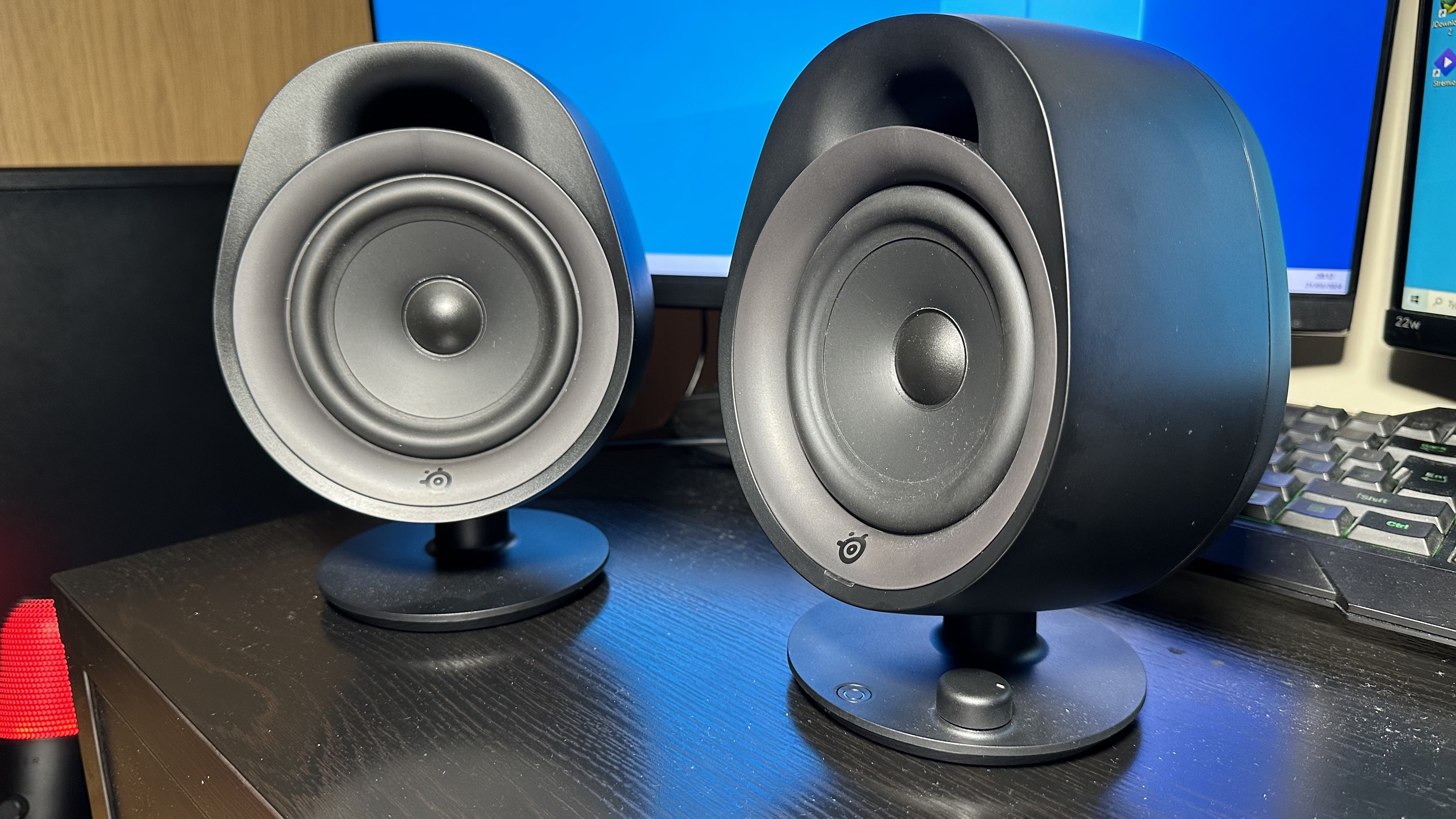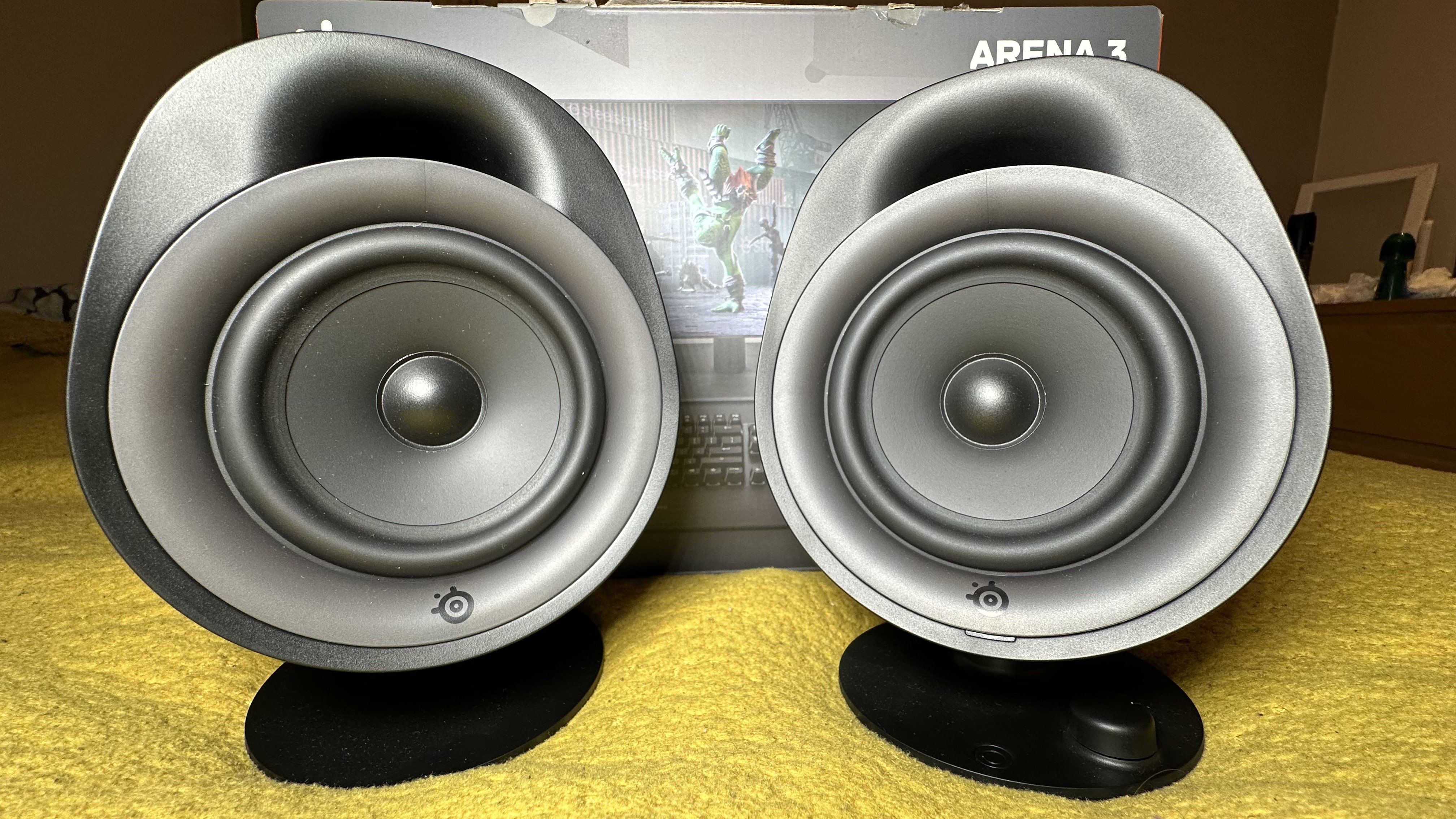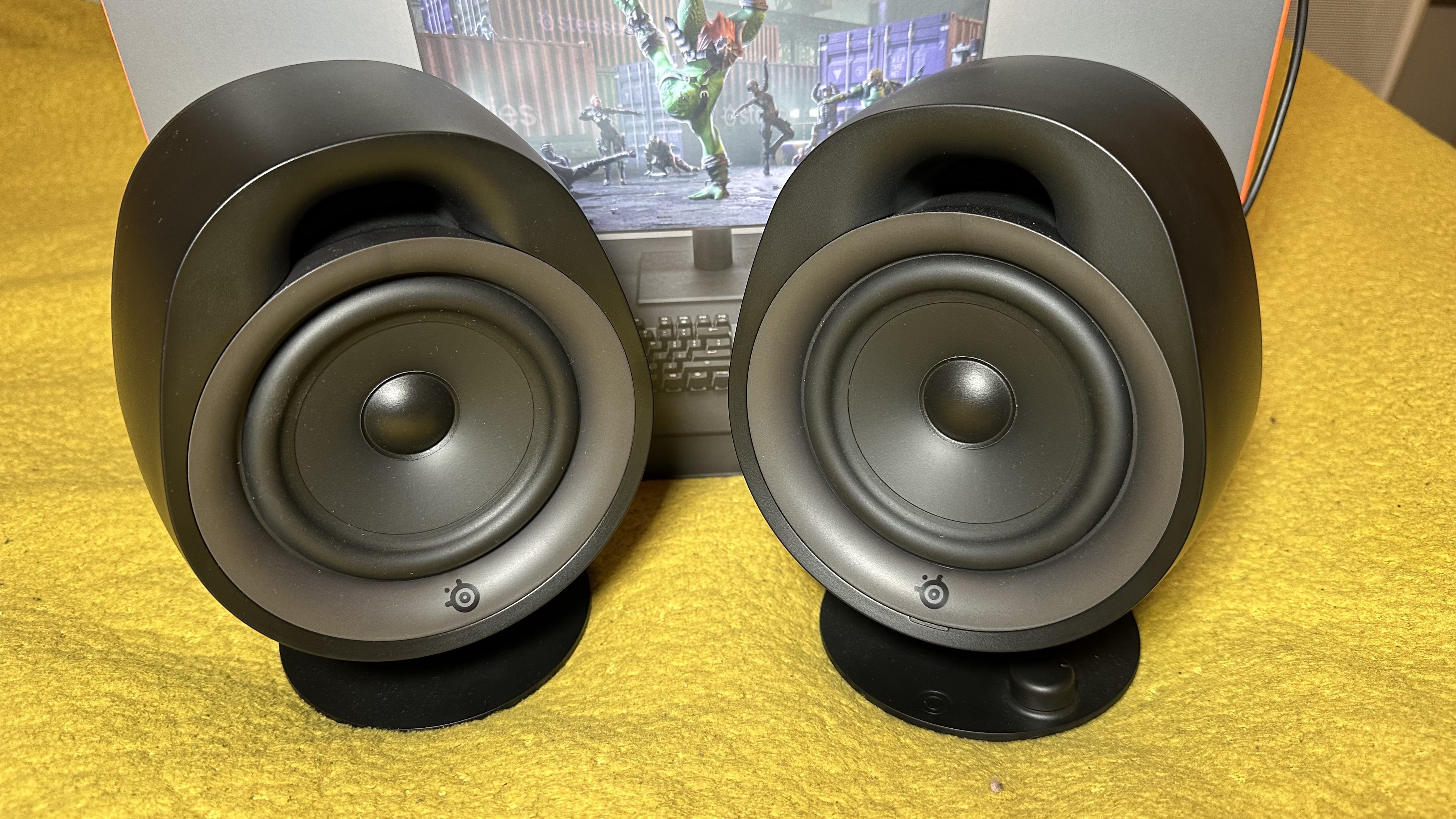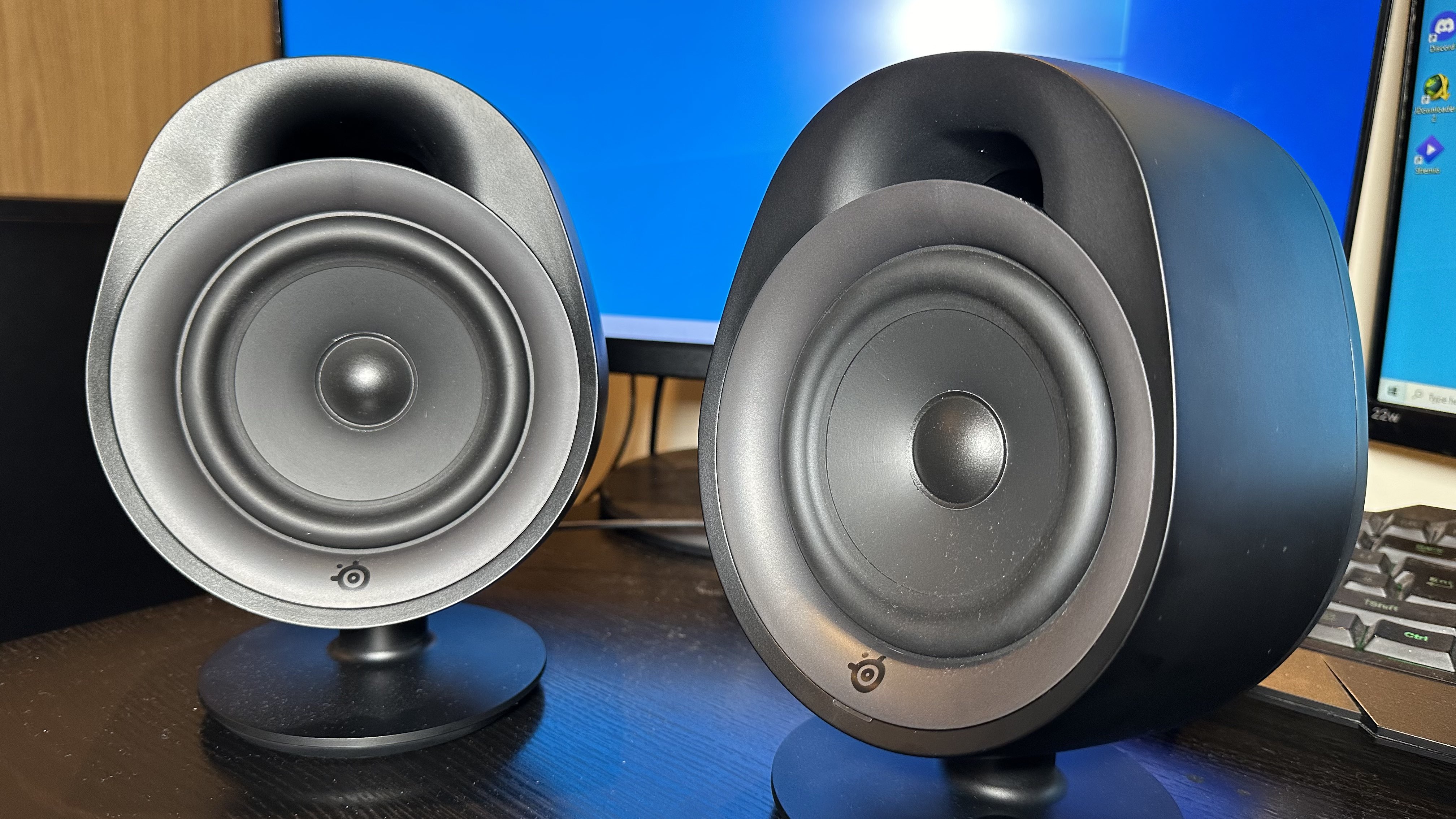GamesRadar+ Verdict
The SteelSeries Arena 3 speakers are a great addition to any gaming PC setup. They come in at a very respectable price without missing out on audio quality, making them one of the best value-for-money purchases if you're searching for the best PC speakers.
Pros
- +
Very accessible price
- +
The sound quality is impressive
- +
Very well built
- +
Good customization options
Cons
- -
Quite large
- -
No USB-C or optical connection
- -
No RGB (if that’s your thing)
Why you can trust GamesRadar+
I had high expectations for the SteelSeries Arena 3 speakers based on the brand's reputation and how well-received the Arena 7 set was when we reviewed it back in 2022. Now that some time has passed since the Arena lineup hit the shelves, how will the lower-end option fare?
Entry-level speakers have a tall order to fill these days. The best options tend to target audiophile purists and as a result, don't compromise on price. The SteelSeries Arena 7 and Arena 9 stand among some of the best computer speakers on the market, but offer separate subwoofers and more devices for their price tags. These would undoubtedly be a solid addition to any of the best gaming PCs, but won't work for everyone's setup.
As the lower-end model in its Arena range, prices for the Arena 3 sit around $129.99/£109.99 compared to the more expensive Arena 7 ($299.99/£299.99) and the Arena 9 ($484.99/£473.99). Your money here gets you two speakers as part of a 2.0 stereo setup, but will that be enough?
Design & Features

Upon unboxing the Arena 3 speakers I was met with a very premium experience. I personally love an unboxing and this was no exception. The speakers themselves are well-designed, with an oval-like shape and a matte black finish. The drivers on the front of the chassis are a slightly lighter color compared to the body which has a more charcoal-like hue. This is similar to the Arena 7 and Arena 9 design except less rounded.
At a glance, they do look fairly high-end, despite their price tag, but also quite muted (visually, not audibly thankfully). You won’t find any fancy RGB or bright lights here - a simple design does the job nicely. Sitting on stands, the speakers can tilt up to roughly 20 degrees to allow you to angle them to suit your setup. I would have liked the ability to rotate them, but sadly, that’s not found here. On the base of the speaker, you’ll find a rubber ring to ensure that the speakers don’t wobble about on your gaming desk or TV stand - not that my setup does wobble much, but it’s nice to have peace of mind that they won’t go flying.
If they did go flying though, I would watch out because the size and weight of these speakers are much larger than I was expecting. While that size lends itself to producing a nice punch to sounds, you might struggle for desk real estate, especially if you have a few of the best gaming monitors on there already. I personally found them a little large for my desk but that’s only a small complaint.
For the lower-end model in the Arena series, I was very impressed with the quality of sound that they produced...
On the front of the right speaker, you’ll find a knob that controls volume and a multi-function button that allows you to switch between audio inputs and enter Bluetooth pairing with support for Bluetooth 5.0. Speaking of audio inputs, you’ll find all of these on the rear of the right speaker and this includes jacks for a headset, AUX, PC, and of course your DC power port. Attached to this is a speaker cable which attaches to the left-hand device and connects the two together. With all the controls and ports on the right speaker, this does mean that one is ever so slightly heavier than the left.
Unfortunately, there is no USB A, USB-C, or optical connectors, something which you might expect speakers to include. It’s not too much of an issue, but it does mean that you’re relying on AUX for the SteelSeries Arena 3 - something the Ruark MR1 MK2 speakers also compromise on. Alongside this, having the headphone jack on the back of the right speaker does make it a little bit inaccessible depending on where the units are placed.
Performance
SteelSeries is known for producing some of the best gaming headsets for both PC and consoles and I am pleased to say that its record continues with the Arena 3 speakers. For the lower-end model in the Arena series, I was very impressed with the quality of sound that they produced, especially compared to my previous speakers which were close to a decade old - this was night and day.
As someone who has mostly relied on headsets as opposed to speakers (something I'm sure my neighbors thank me for), I wasn’t expecting to hear such a difference. I found myself going back and forth between my old speakers and the Arena 3 speakers to determine the quality difference in action. I went to Spotify and played some Low Roar - because I’m a massive Death Stranding fan - and the quality that the Arena 3 displayed was outstanding.

Throughout my testing, I used the Arena 3 speakers alongside the SteelSeries Arctis Nova 7x headset which gave me a good feel for how these devices would compare to SteelSeries' other audio solutions. As someone who primarily uses headphones, I did initially find the move to the Arena 3 strange as I was so used to having sound funneled directly into my head. However, more often than not, I found myself choosing to use the Arena 3 over the Arctis Nova 7x when playing games or listening to music - it just felt more relaxing. I think it depends on the type of content you're enjoying though, I tried out Starfield with both the speakers and the headphones; in that instance, I opted for the headphones as it felt more intimate. The Arena 3 stood out to me more in Assassin’s Creed Mirage, however, with its open world, third-person setting, the Arena 3 really did justice to the historical setting, its ambient sounds, and music.
In musical testing, the Arena 3 performed really well at both very loud levels and when quiet, never losing detail at either end of the dynamic range. When louder, it filled my entire flat with sound - sorry neighbors. As this model doesn't include a Subwoofer like its Arena 7 or Arena 9 counterparts, the sound isn’t quite as full on. Nevertheless, the Arena 3 set doesn't feel lacking in bass - at least, not so much that you’ll really notice unless you’re an audiophile and looking for the best gaming sound systems possible.
More often than not, I found myself choosing to use the Arena 3 over the Arctis Nova 7x when playing games or listening to music...
But it’s not just music where the Arena 3 performs well. During more intense gaming, it does an incredible job of immersing you in virtual worlds. I tested Alan Wake II and Assassins Creed Mirage for this aspect and the former, in particular, impressed me. I began with the now Iconic ‘Initiation: We Sing’ level and was surprised at just how well the Arena 3 enveloped me in the Dark Place. The earworm that is Herald of Darkness blasted through the Arena 3 and filled my flat with crystal-clear Asardian rock. The vocals of the Old Gods of Asgard were picked up well and weren't lost in the often overwhelming mix of metal music. Gunshots packed a punch here with every shot ringing out with weight to it. The Arena 3 speakers were a perfect weapon for jumpscares to wield as well. As a horror fan I do love a good jumpscare and the Arena 3 speakers, when turned up loud, really do Remedy's sound design justice.
SteelSeries’ Arena 3 speakers performed similarly, albeit with fewer jumpscares, in Assassin’s Creed Mirage. The sounds of a bustling Baghdad were picked up very well and were delivered with clarity. I did find however that at one point while entering a cutscene there was some stutter and a little bit of lag from the sound compared to what was on screen, this only happened once and I am inclined to say it was a combination of the game and my PC rather than the speakers themselves. For anyone rocking one of the best graphics cards or the best CPUs for gaming, I doubt it's a problem you'll run into.

As previously mentioned, I also gave Starfield a go using the Arena 3, but I did find myself reaching for the Arctis Nova 7x as my choice when playing. It wasn’t that the Arena 3 delivered a bad experience - on the contrary - I just felt for the more intimate first-person experience the Arena 3 was less effective than using headphones.
Despite only being a 2.0 stereo system I still wanted to test out spatial audio. Although they wouldn't be as viable as headsets for this use case, a couple of spatial audio testing videos produced some impressive results. Despite not being surround sound, the two channels conveyed spatial audio really well. It’s not perfect, but it’s a good attempt for the price.
The speakers do work alongside SteelSeries’ GG software, which allows you to customize the sound of the Arena 3 to your liking, however, I didn’t explore this too much and instead opted to stick with the preset options that come with the Arena 3 - I felt this was the settings that most gamers would likely opt for if they aren’t rocking other gear from the brand, like the SteelSeries Alias Pro microphone.
Should you buy the SteelSeries Arena 3?

Starting at $129.99/£109.99, the Arena 3 speakers won’t break the bank compared to other PC speakers and are very impressive for the relatively cheap entry price. For the money, they delivered a very sound experience - pun fully intended - and delivered exactly what they advertised. I found my time with them to be a great overall experience that delivered across the board for gaming, listening to music, and watching content.
Overall, I found few issues with the SteelSeries Arena 3 and I think the quality of sound they produce is well worth the investment - especially from a big brand like this. However, the lack of USB-C, optical connector, or RGB - if you enjoy that in your gaming tech - is worth noting as these are something the midrange Arena 7 models do include - along with a subwoofer - for roughly $170/£190 more.
Regardless, for the price of the Arena 3, you can’t really go wrong. If you're on the hunt for a simple two-speaker setup for your gaming PC, these stand up against some of the best computer speakers on the market.
How we tested the SteelSeries Arena 3 speakers
The SteelSeries Arena 3 was used alongside my PC for a week as I worked day-to-day and was used as my main output for playing games, watching videos, and listening to music on my PC. I tested the Arena 3 speakers within Alan Wake II, Assassins Creed Mirage, and Starfield. I spent a couple of hours in each to test the capabilities of the speakers. I closely compared my experience with the speakers to using gaming headsets, including the SteelSeries Arctis Nova 7X, which SteelSeries sent me alongside the Arena 3 review sample. I also compared my time with these speakers to my use of older speakers I had in my setup.
Day-to-day I used the Arena 3 to listen to Spotify while using my PC, alongside this I tested them while watching YouTube and some streaming use.
For more on the ways we test the latest gaming tech, you can peruse our hardware policy.
Looking for more gaming PC upgrades? Check out the best PC cases, the best RAM for gaming, and the best Alienware gaming PC.
For as long as I can remember, I've had a fascination with video games and technology. From a young age, I was always reading up on the latest tech and begging my parents to buy it for me - now I have my own job and make my own money, I realize why they often had to say no to my requests. For that reason, I love trying to find the best value gear so I can recommend it when asked. I studied Journalism at Edinburgh Napier University and throughout my time there gaming was one of my main focuses. Alongside Duncan Robertson, I was the co-host of NerdCulture, a weekly gaming and nerdy news radio show. My time as Studio Manager for the uni radio station meant tinkering with a lot of technology to ensure each broadcast worked smoothly. Elsewhere, you can find me discussing professional wrestling as Cultaholic's Community and Social Media Manager, and you'll also see me on the occasional Twitch stream.




